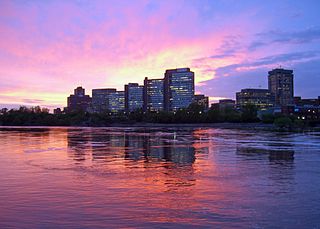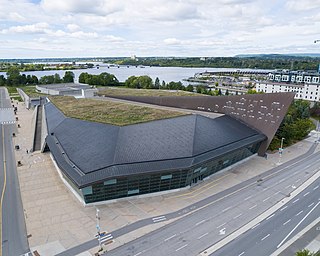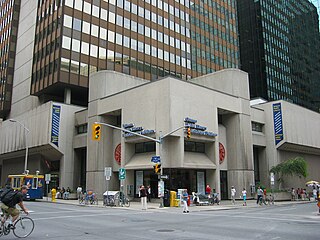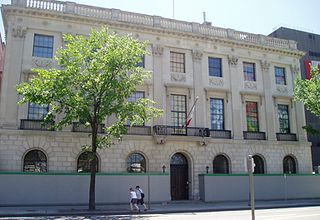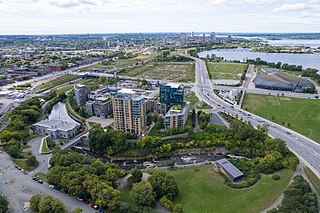Interior Plan and Spatial Configuration

The form of the OPL and LAC Joint Facility is such that it follows the adjacent landscape's undulations evidently seen in the roof's shape which mimics the flow of the Ottawa River. [13] The community influence is the founding reason for the form of the building, as there was a deterrence from the initial traditional rectilinear shape proposed. [5] Instead, the public preferred sinuous and strongly-connected spaces that do not allow for the strict demarcation offered by harsh edges. [13] This involvement of the community is a key element that gives ownership of the building to the people and was further witnessed through the relentless commitment to online consultation, even during the COVID-19 pandemic. This joint consultation process is still continuing between all parties involved. [14]
The building program is set around one of the main features named "the town hall”, which is visible from all 5 levels above ground. [15] This space offers a flexible multi-functioning program that ranges from being a community visiting centre to holding large events. The size and availability of natural light throughout the hall create a central point around which the other spaces are visibly wrapped. It is this absence of sharp edges which allow for smooth circulating spaces and an equal experience for all visitors, of varying accessibility needs. [5] This concept is further witnessed through the choice of glass as the elevator material, opening up the view from different levels for everyone to enjoy. [5]

On the first level, most of the spaces are shared spaces: namely the Exhibition gallery, which aims to showcase artwork and artefacts from the Ottawa Public Library, The Ottawa Community and The Ottawa City Archives in a manner that expresses the concepts of heritage and culture in Canada; to the west is a multipurpose room that can house around 320 people. [15] There are three means of entry: from the east right into the core of the building, along Albert street to the west and access from Pimisi station. Through the west entry there is a café to the left, an OPL designated space straight ahead and the LAC Orientation and Preservation Lab to the right. The centre is a merger of the two institutions, but is split sixty/ forty, giving the Ottawa Public Library a slightly larger claim of space. Below ground houses a large portion of the services and handling spaces for both partners, effectively freeing up space above ground for more communal and educational activity. [13]
An all-inclusive space is one of the main goals of this centre, and therefore has programmed spaces that are meant to appeal to all visitors. The second-level houses a children's discovery and outdoor space that intends to stimulate imagination and engage all the domains of early childhood development by balancing educative and free play inside and outside the building. [15] The floors above the first are shaped in two halves connected by bridge-like connectors. On the second floor these connectors bring together the discovery space and the well-anticipated joint genealogy research room, which combines a vast collection from the two partners. Connected vertically to the children spaces is a teen centre that is in close proximity to a design studio and CNC digital production centre, which further expresses the diversity of spaces present. [16] [5]
The fourth and fifth levels offer an array of adult fiction and non-fiction spaces of which the top level connects to a roof top café. The roof top café has been noted as a key feature, based on its Northern view of the Ottawa River, Chaudière Falls and Parliament hill. The clear view of these Ottawan staples act as a method of wayfinding and works further to ground the building in the landscape. The north and northeast sides of the room are fully glazed allowing for natural light to permeate the atmosphere. Both levels containing the adult collections are in close proximity to the well-awaited reading rooms. The fourth floor houses the largest portion of the LAC's programming, most importantly the LAC reference room which will inform the visitors on military history, sports archives and indigenous history. The fifth floor is the smallest and does not have LAC spaces, but rather shared and strictly OPL programs. The size of which is due to the undulating roof. [16] [15]


